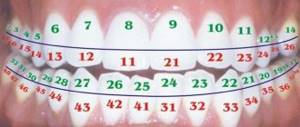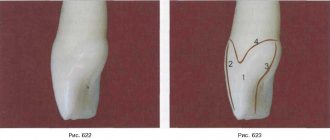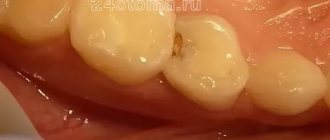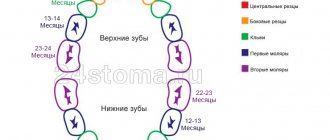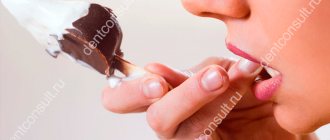Home>Services>Ultrasonic teeth cleaning>Polishing and grinding of teeth
Service Questions and Answers Results from our clients Prices Promotions
Grinding and polishing of teeth is a useful procedure that makes your smile irresistible and your teeth healthy and strong. During this procedure, plaque, which is present in every person, is cleaned from the teeth, and tartar, which is hardened plaque, is also removed.
The procedure, carried out for preventive purposes at least once a year, prevents the formation of tartar and protects teeth from the formation of caries.
9 hours left until the end of the promotion
How does this happen?
The dentist begins grinding and polishing teeth only after complete removal of plaque and tartar from the surface of the teeth.
| Main stages | Information |
| First stage: | First, grinding is done - cleaning out all the irregularities on the surface of the tooth. |
| Final procedure: | Polishing, which is carried out using professional paste and special attachments for a drilling machine. |
The set of nozzles is divided into several types
| Depending on the place of application: | For the final stage: |
| Teeth grinding is carried out using the following additional attachments:
|
Nozzles are divided not only by grain size, but also by intended place of use. For grinding and polishing straight, even surfaces, rollers and discs with a large impact area are used, for example, for cleaning interdental spaces, tools with a narrow working surface are used.
The nozzles move at a speed of about 5000 revolutions per minute, which allows you to quickly and efficiently clean the tooth surface without causing any pain to the patient.
To achieve the desired result, the dentist consistently uses several types of tooth polishing pastes, as well as different types of attachments. Polishing begins with a coarse-grained paste and ends with a fine-grained paste, which removes the remaining minor irregularities of the teeth.
Grinding and polishing the tooth surface is extremely necessary after filling a tooth. Using grinding, the outer edge of the filling is given a smooth and even shape in accordance with the structure of the tooth. This allows you to avoid certain negative consequences associated with discomfort during the process of chewing food or injury to the surrounding mucous membranes and soft tissues.
Tools for polishing the surface of teeth
Polishing the surface of teeth is usually done after removing plaque to provide a smooth surface that prevents plaque retention. Polishing also permanently removes small fragments of mineralized dental plaque and stains on the teeth. The disadvantage of most types of enamel surface polishing is the complete or partial removal of its surface layer, enriched with fluorides. Therefore, it is advisable to treat the polished surface with fluorine-containing solutions. For polishing, special rotating rubber cups (caps) and end brushes, polishing strips, and flosses can be used. Soft rubber polishing caps can be completely hollow or have ridges, bridges or reverse spiral ridges on the inner or outer surface. There are cups with a miniature nylon brush built inside. The figure shows different types of polishing cups (caps).
The caps are fixed in the contra-angle handpiece, filled with polishing paste and polished smooth, sometimes occlusal, surfaces of teeth at a rotation speed of 2000-5000 rpm. The cups can be equipped with protective shields to prevent paste from entering the tip head. Systems for fixing cups on the handpiece can be conventional (for caps equipped with a standard shank for a contra-angle handpiece) or provide for fixation through special holders (mandrels with threads or with a disk). Cups can be of varying rigidity. Thus, soft caps from Densco are blue, medium-hard caps are white, and hard caps are yellow. Edenta's blue super-thin preventive polishers can be used without paste at a rotation speed of 5000 rpm, white cups for pastes - 2000 rpm. For polishing chewing surfaces, it is convenient to use rotating brushes with polishing paste. Brushes can also be used on smooth surfaces if there are stains on them. To clean the interdental spaces, thin, flexible, flat-shaped EVA polishing heads made of wood or plastic are used. When using the EVA system, the interdental spaces are cleaned by vibrating longitudinal vibrations, which are transmitted to the working part. Another way to remove dental plaque from the proximal surfaces of the teeth is to use aluminum oxide-coated polishing strips, also used for polishing composite fillings. For this purpose, flat dental floss or strips with polishing paste, as well as rubber polishing cones for the dental handpiece can also be used. For cleaning and polishing tooth surfaces, the S.E.T. company offered the S.E.T.-Prophy-Leader handpiece - a special tip that provides up and down vertical movement and rotation up to 180° clockwise and counterclockwise (2500 movements per minute). Special tools (green and brown polishers, brushes) with a curved shank have been developed for the tip.
If you find an error, please select a piece of text and hold LEFT Ctrl and press Enter.
You can send no more than 5 messages in 30 minutes!
Liked? Tell your friends!
Why polish and grind your teeth?
Grinding and polishing of teeth is part of a set of procedures for cleaning teeth from plaque and stones.
After removing stones using ultrasound or laser, the surface of the teeth becomes somewhat rough. This is not visually visible, but the patient feels this discomfort and the surrounding mucous membranes are constantly irritated. Roughness contributes to the rapid accumulation of plaque and bacteria, which exacerbate inflammatory processes in the oral cavity.
It is for the purpose of removing these roughnesses that grinding and polishing of teeth is carried out. On the smooth surface of teeth, plaque does not linger for long and bacteria have nothing to cling to. This means that the growth of a new layer of plaque, and especially the formation of tartar, will not bother you for a long time.
Selective grinding of the enamel of individual teeth
In orthodontic clinical practice, the cusps and proximal surfaces of individual teeth, both temporary and permanent, are selectively ground down at different periods of treatment - at the beginning or after the end. Indications for such treatment are as follows. The first indication is the presence during the period of mixed occlusion of unworn cusps of temporary fangs, most often on the lower jaw, causing it to shift forward, to the side or making it difficult to advance. Grinding of the cusps of the latter is indicated, and, if necessary, the use of orthodontic appliances to eliminate malocclusions. The second indication is palatal deviation of the permanent lateral incisors of the upper jaw during the period of their eruption in the presence of high unworn cusps of the temporary canines of the lower jaw, preventing the installation of the incisors into the dentition. Grinding of the cusps of temporary canines is indicated. After grinding the cusps of the temporary canines of the lower jaw, self-regulation of the position of the anterior teeth occurs, which was established when checking the results of treatment over a period of 5 years. The third indication is a narrowing of the upper dentition, unilateral or bilateral mixed crossbite. Partial grinding of the cusps of temporary canines and molars on the side of the crossbite is indicated, which facilitates the expansion of the upper dentition. The cusps of individual teeth are polished mainly with diamond heads. This procedure is performed by briefly touching them under visual control of the contacts of the dentition with various types of articulation. The occlusion method is used. The cusps of individual teeth should be ground to the intended level, maintaining their anatomical shape. It is better to plan a one-time grinding of the cusps of the teeth. When re-grinding the cusps of the same teeth over and over again, after a few days, an increase in the sensitivity of the enamel is noted. In this regard, remineralization therapy is indicated. You can use orthodontic devices that expand the dentition, lengthen it, and move individual teeth, which speeds up treatment and ensures the effectiveness of its results. The fourth indication is a significant difference in the mesiodistal dimensions of the crowns of the first and second temporary molars on the upper and lower jaws, improper closure of the first permanent molars. It is shown to grind the proximal surfaces of the crowns of temporary molars on the jaw where the sum of their sizes is greater, which contributes to the mesial displacement of the lateral teeth and normalization of the closure of the first permanent molars. The fifth indication is early loss of the second temporary molars on one jaw, mesial displacement of the first permanent molars on the same jaw, disruption of occlusal contacts with the molars of the opposite jaw. Grinding of the distal areas of the enamel of the second temporary molars is indicated to normalize the bite. The sixth indication is the need to place the wire parts of the Frenkel function regulator of types I and II on the canines of the upper jaw with their emphasis in the cervical region of the mesial surface of the crowns of the canines and first temporary molars, and the palatal clasp in the same area of the crowns of the first permanent molars. It is indicated, as advised by R. Frankel, partial grinding of the enamel on the mesial surface of the temporary canines and first temporary molars, as well as on the distal surface of the second temporary molars (Fig. 19.13).
Rice. 19.13. Partial grinding of the enamel of temporary canines and molars in the area of their contacting surfaces when using Frenkel function regulators of types I and II. 1 — view from the vestibular surface of the upper dentition; 2 — view from its occlusal surface; 3 - location of the wire parts of the Frenkel function regulator of types I and II, transmitting pressure in the distal direction to the cervical areas of the first temporary and first permanent molars, as well as hooks on the canines and palatal clasp; 4 - view from the occlusal surface - location of the side shield of the regulator and the ends of the wire parts.
Grinding the proximal surfaces of primary teeth using a regulator of Frenkel functions of types I and II accelerates their development, helps to delay the mesial migration of the teeth of the upper jaw, which, with the mesial movement of the teeth of the lower jaw, ensures the best interdental contacts. The seventh indication is a violation of contacts between the dentition with different types and articulation. Grinding of the cutting edges and cusps of individual temporary or permanent teeth is indicated during the period of both mixed and permanent dentition. The eighth indication is a violation of the shape of the cutting edge of the permanent incisors or the tubercle of the permanent canines (usually the upper jaw) as a result of partial fracture of the enamel, its hypoplasia, the presence of tubercles on the cutting edge of the incisors, with an acute-angled shape of the tubercle at the fangs. In order to improve the aesthetics after dentoalveolar traction of such teeth, using edgewise technology, the cutting edges of the incisors are aligned, and the canine cusp is also rounded by partially grinding the enamel. The ninth indication is a lack of space in the dental arch for individual teeth during the period of permanent dentition. For individual teeth, this space can be created by moving teeth apart, eliminating diastema and trema, lengthening or widening dental arches, and also, for certain indications, by grinding the proximal surfaces of permanent anterior and posterior teeth. This method of treatment is chosen after a thorough multilateral examination of the patient, taking into account the severity of functional, morphological and aesthetic disorders in the dentofacial area. After grinding teeth in adults, dental anomalies are corrected using orthodontic appliances. In children and adolescents, this method of treatment is used less frequently. Grinding of the proximal surface of the teeth is carried out in order to create space for setting the teeth in the correct position, improve the shape of the teeth, remove excess fillings, normalize the ratio of the length and width of the dental arches, ensure the coincidence of the midline between the central incisors of the upper and lower jaws, and speed up orthodontic treatment. When indications for grinding the proximal surfaces of permanent teeth are taken into account: 1) the shape of the crowns and their mesiodistal dimensions; 2) patient's age; 3) the thickness of the enamel coating of various teeth; 4) the condition of the hard tissues of the teeth; 5) anomalies in the position of teeth; 6) anomalies in the width, length and shape of the dental arches; 7) face shape; sagittal, transversal and vertical malocclusions. The shape of the crowns of the teeth is interconnected with the shape of the face and the constitution of a person. The mesiodistal dimensions of the teeth should be taken into account when determining interdental contacts. When the teeth are closely positioned, the cutting edges of the incisors are significantly wide, the presence of interdental contacts approaching their occlusal side, partial grinding of the enamel in the contact area is most effective, since it allows you to increase the space for incorrectly located teeth, improve the shape of the incisors and achieve a harmonious ratio of their width with width of the nose. When the crowns of the maxillary incisors are barrel-shaped, after grinding their contacting proximal surfaces, the shape of the teeth improves, the triangular-shaped spaces at the cutting edge of these teeth are reduced, and space is freed up for correction of the abnormal position of individual teeth, most often canines (Fig. 19.14).
Such a treatment is carried out according to indications in the area of the anterior and lateral teeth after calculating the lack of space for placing abnormally located teeth, taking into account the need to correct the midline between the central incisors of the upper and lower jaws
(Fig. 19.15).
Rice. 19.14. Partial grinding of enamel from the proximal surface of adjacent teeth using abrasive strips (1), abrasive metal disks (2), the shape of the dental arch after grinding the enamel and correcting the position of the teeth using the edgewise technique (3).
From each tooth, the enamel is ground down in the area of interdental contact to 0.25 mm of its thickness. Before starting treatment, the space deficit in the dental arch for incorrectly positioned teeth is calculated in millimeters and the possibility of its creation is determined. After grinding the proximal interdental contacts in the area of the incisors, a space of 2 mm can be obtained, in the area of 4 incisors and canines - 3 mm. The thickness of the enamel of premolars and permanent molars is greater than that of the incisors. In this regard, the enamel of the posterior teeth can be ground down to 0.5 mm, as evidenced by studies carried out by JJ Sheridan. After filing down the contact areas in the area of premolars and molars, it is possible to obtain space in the dental arch for incorrectly positioned teeth of 3 mm on each side, i.e. a total of 6 mm. In some cases, such a treatment may be an alternative to the removal of individual teeth for the purpose of orthodontic treatment (Fig. 19.16).
When deciding whether a treatment is appropriate, the condition of the hard tissues of the teeth is taken into account. In case of multiple caries, this is done with the condition of subsequent prosthetics, namely strengthening artificial crowns on the teeth. If the proximal surfaces of the teeth are restored with fillings or inlays, they can be ground down. Part of the enamel in the area of interdental contacts is ground off according to indications and in the presence of intact closely spaced teeth for the purpose of subsequent orthodontic treatment. It is necessary to make entries in the medical history indicating the date of grinding of the teeth so that such an event is not accidentally repeated during the treatment process. Teeth are ground before the start of orthodontic treatment, less often after its completion, when the teeth are stable. In the lower jaw, during orthodontic treatment, it is advisable not to change the intercanine width or to change it slightly, which ensures retention of the achieved results.
Rice. 19.16. Grinding away the enamel on the proximal surfaces of the crowns of premolars and molars and then moving them distally to create space for malpositioned anterior teeth. a — side view (1, 2, 3); b — view from the chewing surface (1, 2, 3).
After grinding off the interdental contacts of the enamel and completing the treatment of crowded teeth using orthodontic appliances, checking the periodontal status indicates its normal condition. Indications for grinding the proximal areas of the enamel of permanent teeth and the results of subsequent orthodontic treatment are most fully covered by US specialists in the American Journal of Orthodontic and Journal of Clinical Orthodontic since 1956. In publications before 1970, attention was paid to grinding in the area of the anterior teeth. teeth In the last decade, mainly the results of treatment after partial grinding of the enamel of the lateral teeth have been described. JJSheridan developed an enamel grinding technique, tools, and a special gauge to make it easier to determine the thickness of the sawed enamel (Fig. 19.17).
Rice. 19.17. Sheridan meter for determining the thickness of sawn enamel and the technique of its use.
When assessing the results of treatment, it was found that grinding the enamel of individual teeth accelerates the self-regulation of anomalies, as well as orthodontic treatment using removable or fixed orthodontic appliances and allows achieving positive results.
Selective grinding of the cusps of individual temporary and permanent teeth should be carried out in orthodontic practice in order to prevent malocclusions, speed up treatment, increase its effectiveness, ensure correct articulatory contacts between the dentition, prevent periodontal overload, displacement of the lower jaw and diseases of the temporomandibular joints. Grinding of the proximal surfaces of temporary teeth is indicated when there is a significant difference in the sum of the mesiodistal dimensions of the crowns of temporary molars on the upper and lower jaws, as well as after the early loss of second temporary molars on one jaw in order to normalize the interocclusal contacts of the first permanent molars. It is shown when fitting the regulator of Frenkel functions of types I and II.
Grinding of the proximal surfaces of permanent teeth should be carried out after a thorough analysis of the results of clinical and radiological examinations of the dentoalveolar arches, measuring diagnostic models of the jaws and identifying the lack of space for incorrectly positioned teeth, assessing the quality of teeth and periodontal tissue in the patient and his parents, as well as the hygienic maintenance of the oral cavity.
Indications and contraindications
Polished teeth not only provide an aesthetically pleasing smile, but grinding and polishing can also reduce the number of visits to the doctor that are limited to preventive procedures.
| Procedure recommended | Unwanted interference |
Grinding and polishing the surface of teeth is indicated for:
| Contraindications to grinding and polishing may be:
|
Almost any dental procedure (caries treatment, teeth whitening, teeth cleaning) usually ends with grinding and polishing.
Grinding and polishing is an absolutely painless procedure that has virtually no contraindications or side effects. After treatment and removal of the inflammatory process, grinding and polishing of the teeth is carried out to consolidate the result.
After carefully carrying out these activities, some temporary discomfort may occur:
- temporary exacerbation of hypersensitivity to the external environment;
- unusual sensations in the oral cavity, which are associated with the removal of excess plaque on the teeth;
- tobacco smoking, in which the number of cigarettes smoked exceeds 20 pieces (smoking weakens the tooth enamel, which has been cleared of plaque, and quickly gives the teeth a yellowish tint).
After such a thorough and high-quality teeth cleaning, experts recommend limiting the consumption of coloring products for 2 days so that there are no dark spots left on the tooth enamel. Limit smoking so that tooth enamel has time to strengthen and adapt to external irritants.
For high-quality grinding and polishing of teeth, contact the specialists of the Diamant aesthetic dentistry clinic. A beautiful and healthy smile is a significant part of achieving success in life.
Grinding teeth
Periodontal disease is a common cause of tooth loss. Only regular visits to the dentist will allow you to detect the causes of the disease in time and take timely measures. You need to know that periodontal diseases are treatable, you just need to not let the disease progress. The sooner treatment begins, the easier the path to recovery. The periodontist plays an important role, because he will have to correct and slow down the development of periodontal disease. With timely and proper treatment, the service life of teeth can be extended by 10-15, or even more years. Successful treatment of periodontal diseases largely depends on ensuring normal distribution of load on the teeth or eliminating functional overload of the teeth. The doctor examines the patient to determine the causes and mechanism of development of dental overload. If uneven occlusal contacts of the teeth are detected, which lead to horizontal traumatic overload of the teeth, the periodontist prescribes grinding of the teeth. Indeed, with each closure of the dentition, due to these contacts, the teeth deviate in the corresponding direction, causing compression of the periodontium, which enhances the resorption of bone tissue. Models of the dentition are made, which are used during research on a special device, an articulator, that reproduces the movements of the lower jaw. Grinding on plaster models makes it possible to correctly draw up a plan and sequence of grinding. After professional teeth cleaning and oral sanitation, the doctor plans further treatment. Grinding is carried out with special tools with a fine-grained surface, after which the tooth is treated with fluoride preparations. To eliminate premature occlusal contacts, selective grinding is performed. Usually about five visits are needed at intervals of 8-10 days. And then visit the periodontist once a year for observation and possible correction.
+7 Call back
Working hours
| Mon-Fri | 10:00 — 22:00 |
| Sat-Sun | 10:00 — 20:00 |
Krukovskaya Natalya Vladimirovna Dermatocosmetologist
LATEST ARTICLES
Sinus lifting in dentistry: risk or help? Bone grafting during implantation: indications, types Hemisection of the tooth: indications, methods of implementation Methods for lengthening the coronal part of the tooth Painless removal of baby teeth
Treatment of tooth root caries
The main problem in treating tooth root caries is gaining access to the lesion. Therefore, the stages of treatment proceed according to the following scenario.
- Retraction is the lowering of the gum edge using special threads.
- Elimination of overgrown gum tissue.
- Direct treatment of caries. If it is possible to diagnose a patient with root caries in the spot stage, then treatment will be reduced to a fluoride remineralization procedure and the prescription of a course of calcium-containing medications. The advantage is that the cement tissue of the tooth is much more susceptible to remineralizing therapy, and thanks to this property, treatment and restoration of the tissue occurs quite quickly. If the disease has managed to lead to a defect in hard tissues, drilling and filling of root caries will be required.
- Installation of an inlay or crown (relevant if the tooth is more than half destroyed).
Treatment of tooth root caries should be carried out by a specialist with extensive experience and high qualifications, since the procedure, due to the close proximity of the vessels, requires especially careful manipulation of instruments. During treatment, special drugs are used that minimize the risk of further damage. To make sure that all infected areas have been removed, a caries indicator is used - a special substance that is used to fill the cleaned cavity. To fill root caries, materials are used that protect the tooth from secondary caries under the filling.
Safety
In the process of chewing food, our teeth face much more stress and negative influences than during brushing. Hard and soft plaque accumulated in the oral cavity provokes an unpleasant odor and creates an environment for pathogenic flora.
Foci of infection arise where conditions are created for this. Therefore, grinding your teeth not only makes your mouth cleaner, but also blocks the growth of bacteria.
Plus, healthy white teeth are beautiful. The enamel layer not only is not destroyed, but, on the contrary, is cleaned and restored.
Contraindications
There are contraindications for the procedure. Before cleaning, you must agree with your dentist.
Not recommended:
- In case of allergic reactions to components of substances used in grinding.
- For kidney diseases, when one of the elements of therapy is a salt-free diet.
- When there are ulcers or inflammation of the mucous membrane in the oral cavity.
- For acute viral infections.
- Periodontitis.
- In the case when several teeth are affected by caries.
- For bleeding and inflamed gums.
- In case of fragile and thin tooth enamel.
You must first eliminate the cause of the contraindications, and then carry out cleaning.
Features of the Zoom teeth whitening technique, reviews from patients and specialists. See photos of Clarity Advanced braces here.
At this address https://dr-zubov.ru/krasota-i-uxod/preparaty-i-produkty/vrednye-dlya-emali-chto-ogranichit-i-chto-isklyuchit-iz-raciona.html we offer detailed information about products that destroy teeth.
Prices
The cost of the service depends on dentistry and its level and equipment. It is important which treatment method is chosen. Prices are indicated in the number of units or the entire oral cavity. The best option is to brush all your teeth.
On average, the price per unit ranges from 100 to 200 rubles. Many dental clinics offer installment plans. When filling teeth, grinding is included in the general price list, unlike polishing.
Materials play an important role. As a rule, expensive clinics use higher quality ones. This point should be reflected in the price list, where the manufacturer is indicated. Find out what alternative pricing option they can offer you.
Watch the video for the process of polishing seams on teeth.
